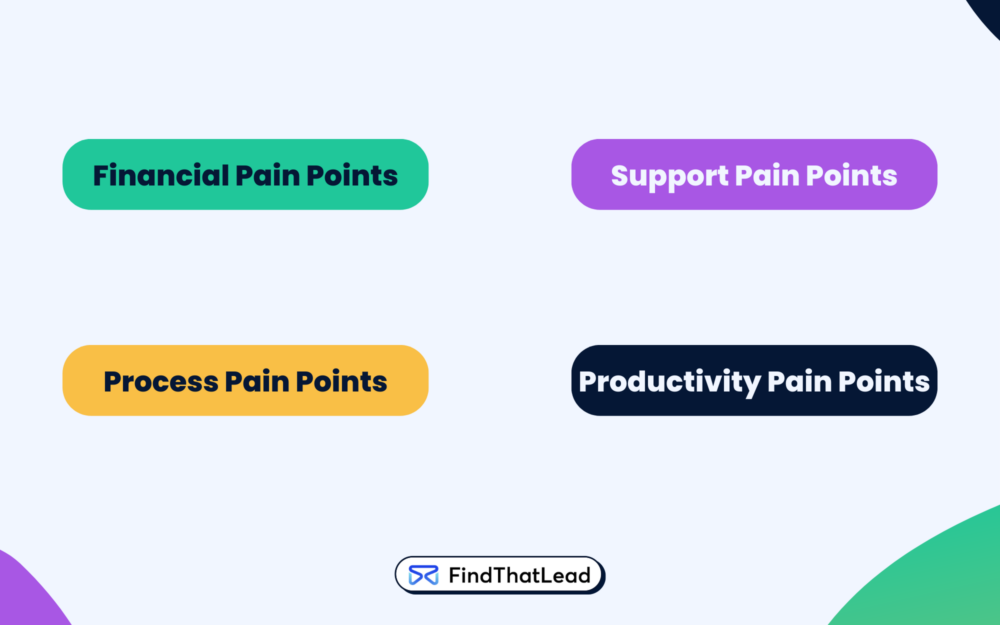There’s a term that’s often mentioned but not always fully understood in the world of sales and marketing: “pain points”. These are the challenges and problems your customers face, the hurdles that prevent them from achieving their goals. “Pain points” are specific problems that your customers encounter. It could be minor annoyances or significant obstacles, but they all represent an opportunity for your business to step in and provide a solution. But to do that, we need to understand them in detail.
Understanding Pain Points in Detail
Let’s take a step back and really get into the nitty-gritty of pain points. What are they exactly in the context of business and marketing? Why are they more than just customer complaints? And why is it so important to identify them in the customer journey? Let’s break it down.
What are Pain Points in Business and Marketing?
In the business and marketing world, pain points are the problems that customers experience. They’re the significant challenges that prevent customers from achieving their goals. These could be as simple as a product feature that doesn’t work as expected, or as complex as a complete disconnect between the customer’s needs and the solutions a business provides.
Understanding these pain points is the first step in providing real value to your customers.
Pain Points: More Than Just Customer Complaints
It’s easy to dismiss pain points as just customer complaints, but they’re so much more than that. They’re signals of deeper issues that need to be addressed. They’re opportunities for businesses to improve their products, services, and overall customer experience. So, the next time you hear a customer complaint, don’t just brush it off, see it as an opportunity to dig deeper and uncover the real pain point.
The Importance of Identifying Pain Points in the Customer Journey
Identifying pain points is a crucial step in the customer journey. It’s not just about solving problems, it’s about understanding your customers on a deeper level. By understanding what problems your customers are facing, you can tailor your products and services to meet their needs and provide real value.
Plus, it shows your customers that you’re listening and that you care about their experience, which can help build trust and loyalty.
Types of Customer Pain Points
Alright, now that we’ve got a solid understanding of what pain points are, let’s talk about the different types. Not all pain points are created equal, and they can fall into few categories. Let’s dive into each one.

Financial Pain Points
We all know money matters. Financial pain points are those that involve money. These could be concerns about overpriced products or services, or confusion about spending and budgeting. Maybe a customer feels like they’re not getting enough bang for their buck, or they’re unsure about the financial commitment of a subscription service.
Whatever the case, these pain points all come down to dollars and cents.
Process Pain Points
Ever feel like something is just more complicated than it needs to be? That’s a process pain point. These are the pain points that deal with the processes within customers’ daily lives. These could be time-consuming tasks or complicated methods that make it difficult for customers to achieve their goals.
Whether it’s a confusing checkout process on a website or a convoluted return policy, these pain points are all about the need for a smoother, more efficient process.
Productivity Pain Points
Time is money, right? Productivity pain points are those that stem from a lack of streamlined experiences or efficiencies. These could be situations where time and resources aren’t utilized properly, leading to frustration and decreased productivity. Maybe a software tool is too complex and time consuming, or a service doesn’t integrate well with a customer’s existing workflow. These pain points highlight the need for solutions that save time and increase efficiency.
Support Pain Points
Nobody likes to feel like they’re on their own, especially when they’re facing a problem. Support pain points are those that make customers feel like they don’t have the help they need. These could be confusing tasks and processes or a lack of guidance and support from the business.
Whether it’s a slow response time from customer service or unclear instructions for product assembly, these pain points underscore the importance of reliable, effective customer support.
Identifying and Analyzing Customer Pain Points
So, we’ve got a handle on what pain points are and the different types. But how do we find them? And once we’ve found them, what do we do with them? Let’s get into the how-to of identifying and analyzing customer pain points.
Techniques to Discover Customer Pain Points
Finding pain points isn’t always easy. Sometimes, they’re right there on the surface, but other times, they’re hidden deep beneath layers of customer feedback and data. But don’t worry, there are several techniques you can use to uncover these hidden gems.
This could involve conducting customer research and surveys, using correct outbound techniques, applying social listening tactics, using a and setting up a live chat feature on your website. The key is to be proactive and intentional in your search for pain points.
The Role of Sales Teams in Uncovering Pain Points
Your sales team is on the front lines, interacting with customers every day. This puts them in a prime position to uncover pain points. They can listen for common complaints, observe where customers struggle, and ask direct questions about what could be improved. By equipping your sales team with the right tools and training, they can be a valuable resource in your quest to identify and address customer pain points.
Using Customer Feedback to Understand Common Pain Points
Customer feedback is like a treasure trove of insights into customer pain points. Whether it’s through surveys, reviews, or direct communication, customers are often more than willing to share their challenges and frustrations. By paying close attention to this feedback, you can identify common pain points and work towards solutions that address them.
Setting Up a Live Chat Feature
A live chat feature on your website can be a powerful tool for identifying customer pain points. It allows you to engage with your customers in real time, providing immediate assistance and gathering valuable insights.
Plus, it shows your customers that you’re there when they need you, which can go a long way in building trust and loyalty.
Common Pain Points in Business and Marketing
While pain points can vary greatly depending on the customer and the industry, there are some common challenges that many customers face across different businesses. Let’s take a closer look at these.
Delayed Support Responses
We’ve all been there, waiting on hold for what seems like an eternity, only to be told that the wait could be hours. When customers can’t get a support response in a reasonable time frame, it can lead to further frustration and stress.
This is a common pain point that businesses need to address to improve the customer experience. Businesses can tackle this pain point by investing in their customer support teams, implementing efficient customer service software, and setting clear expectations about response times.
Inconsistent Experience
Consistency is key in providing a great customer experience. If a customer has a good experience the first time they buy from a brand, then a bad experience the next time, it can lead to frustration and distrust in the brand. Ensuring a consistent buyer journey across all channels and platforms is crucial in addressing this pain point.
This could involve standardizing processes, training staff to provide consistent service, and regularly checking in with customers to ensure their experiences are meeting expectations.
Lack of Communication
In today’s digital age, customers expect 24/7 customer service. When a customer can’t get an answer or doesn’t have a clear line of communication with a support team, it can be challenging. Brands need to ensure they have effective communication channels in place to address this common pain point.
This could involve setting up multiple communication channels (like email, phone, live chat, and social media), ensuring quick response times, and training staff to communicate clearly and effectively.
Poor Quality Products and Services
Quality is a major factor in customer satisfaction. If a customer doesn’t receive quality products or services, it’s hard for them to trust the brand. Businesses need to ensure they are delivering high-quality products and services to address this pain point. This could involve investing in product development, implementing strict quality control measures, and regularly gathering customer feedback to make improvements.
Lack of Knowledge and Experience
When a customer contacts a support team, they expect the team to have the answers to their problems. If a support team lacks the knowledge or experience to provide effective solutions, it can lead to distrust in the brand from the customer.
Businesses can address this pain point by investing in training and development for their support teams, creating comprehensive knowledge bases, and fostering a culture of continuous learning and improvement.
Complicated Buyer Processes
In today’s fast-paced world, customers value convenience. If a checkout process is too long, has too many steps, or requires too much information, customers may abandon their carts or look for other solutions that are easier to navigate.
Simplifying the buying process is key to addressing this common pain point. This could involve streamlining the checkout process, offering multiple payment options, and ensuring the process is intuitive and user-friendly.
How to Solve Pain Points Effectively
Alright, we’ve identified the pain points, we know what they are, and we understand their impact. But now comes the big question: how do we solve them effectively? This isn’t just about putting a band-aid on a wound. It’s about finding the root cause, addressing it, and making sure it doesn’t happen again. Let’s roll up our sleeves and get into it.
Strategies to Address Customer Pain Points
First things first, we need a strategy. This isn’t a one-size-fits-all kind of deal. Each pain point is unique and requires a tailored approach. This could involve asking customers about their needs, offering solutions and options, and following up with customers to ensure the pain point has been resolved. But it’s not just about solving the problem, it’s about turning the entire experience into a positive one.
This means communicating clearly, providing excellent customer service, and showing the customer that you value their feedback. It’s about creating a better customer experience at every step of the journey.
The Role of Marketing in Solving Pain Points
Marketing isn’t just about promoting products or services. It’s about understanding the customer and their needs. The marketing team plays a crucial role in solving pain points. They can create targeted messages that address specific pain points, use customer feedback to improve products and services and work closely with other teams to ensure a unified approach to solving pain points.
But it’s not just about solving the problem, it’s about preventing it from happening again. This means using the insights gained from solving pain points to improve future marketing campaigns and product development.
Ensuring Efficient Resolution of Pain Points to Enhance Customer Journey
Efficiency is key when it comes to resolving pain points. The quicker a pain point is identified and resolved, the better the customer journey. This could involve setting up a live chat feature on your website, training your support team to handle common pain points, or using technology to streamline processes and make things easier for the customer.
But it’s not just about solving the problem quickly, it’s about making sure it doesn’t happen again. This means continuously monitoring and improving your processes to prevent the same pain points from recurring.
Asking Customers About Their Needs
One of the best ways to solve customer pain points? Just ask. This not only helps the customer feel important and valued, but it also gives you valuable feedback about the customer experience. By asking customers about their needs, you can identify pain points you might not have been aware of and work towards solutions that address them.
But it’s not just about asking, it’s about listening. This means taking the time to understand the customer’s feedback, empathizing with their experience, and showing them that you’re committed to improving their experience.
Offering Solutions and Giving Options
When a pain point arises, be ready with solutions. Whether a customer is coming to you from another brand or is having an issue with your products or services, having options ready can help turn every interaction into a positive one. This could involve offering alternative products, providing additional support, or even creating custom solutions for unique pain points.
But it’s not just about offering solutions, it’s about empowering the customer. This means giving them the information and tools they need to make informed decisions, and showing them that you’re there to support them every step of the way.
Following Up with Customers
Don’t forget to follow up. If a customer has come to you for a solution, make sure to follow up with that customer to see if the solution fixed the pain point. This can help build trust and improve the customer experience. Make sure you have a solid customer success strategy.
But it’s not just about checking in, it’s about showing the customer that you care about their experience beyond the point of purchase. This means asking for feedback, offering additional support, and showing appreciation for their business.
Aligning Your Solutions to Customer Needs
Finally, make sure your solutions align with customer needs. Once you’ve identified the problems your customers are facing, you can work to provide clear alternatives to their challenges. This not only increases customer satisfaction but also helps your brand stand out from the competition.
But it’s not just about providing solutions, it’s about creating a better overall experience. This means considering the customer’s needs at every stage of the journey, from the first point of contact to the post-purchase follow-up.
Real-Life Pain Points Examples and Success Stories
We’ve talked a lot about pain points and how to solve them. But let’s get real. Let’s look at some examples of real-life pain points and how businesses have successfully addressed them.
Example 1: Slow Website Speed
Imagine you’re a customer trying to make a purchase on a website, but the pages take forever to load. You’re clicking and waiting, clicking and waiting, but nothing happens. It’s frustrating, right? This is a common pain point for many online shoppers. Slow website speed can lead to a poor user experience, cart abandonment, and ultimately, lost sales.
Now, let’s look at how a business could address this issue. A business that noticed this issue could invest in improving its website speed. This could involve optimizing images, reducing server response time, and minimizing the use of render-blocking JavaScript. By doing this, they could provide a smoother and more enjoyable shopping experience for their customers.
But it’s not just about making these changes. It’s also about monitoring website speed on an ongoing basis and making adjustments as needed. This could involve using tools like Google PageSpeed Insights to track website speed and identify areas for improvement.
Example 2: Poor Customer Service
We’ve all had those experiences where we’ve needed help from a company, but the customer service was less than stellar. Maybe you were put on hold for a long time, or the representative you spoke with was rude or unhelpful. Poor customer service is a major pain point for many customers and can lead to a negative perception of a brand.
So, how could a business address this issue? A business that recognized this issue could invest in training for its customer service team. This could involve teaching them effective communication skills, problem-solving techniques, and empathy. The goal would be to ensure that every customer interaction is positive and helpful.
But again, it’s not just about making these changes. It’s also about continuously monitoring and improving customer service. This could involve regularly gathering customer feedback, conducting performance reviews, and providing ongoing training and support for customer service staff.
Example 3: Complicated Checkout Process
Imagine you’re shopping online, you’ve found exactly what you want, and you’re ready to make a purchase. But when you get to the checkout page, it’s a maze of forms, options, and steps. You need to create an account, fill in a dozen fields, and navigate through several pages before you can finally place your order.
It’s a hassle, and it’s enough to make you reconsider your purchase. This is a common pain point that can lead to cart abandonment.
A business that noticed this issue could streamline their checkout process. This could involve reducing the number of steps in the checkout process, offering guest checkout options, and making forms as simple and intuitive as possible. The goal would be to make it as easy as possible for customers to complete their purchases.
But the work doesn’t stop there. Continuously testing and optimizing the checkout process is key. This could involve using A/B testing to compare different checkout designs, gathering customer feedback to identify areas for improvement, and staying up-to-date with best practices in checkout design.
Example 4: Lack of Product Information
You’re shopping for a new laptop online. You’ve found a model that looks promising, but you’re not sure if it has all the features you need. You look for more information, but the product description is vague and incomplete. You’re left with questions, and without answers, you’re hesitant to make a purchase. This is a common pain point for many online shoppers.
A business that recognized this issue could improve its product descriptions and provide more detailed information. This could involve including detailed specifications, user reviews, and even video demonstrations. The aim would be to provide customers with all the information they need to make an informed purchase.
However, it’s not a one-and-done deal. Regularly updating product information based on customer feedback and queries, and ensuring that all product information is accurate and up-to-date, is an ongoing task that can help to continually improve the customer experience.







 BONUS:
BONUS: The Challenge: Join this free course and I guarantee that after 5 days you will have the necessary skills to start generating B2B clients Growth Hacking and Prospecting techniques.
The Challenge: Join this free course and I guarantee that after 5 days you will have the necessary skills to start generating B2B clients Growth Hacking and Prospecting techniques.